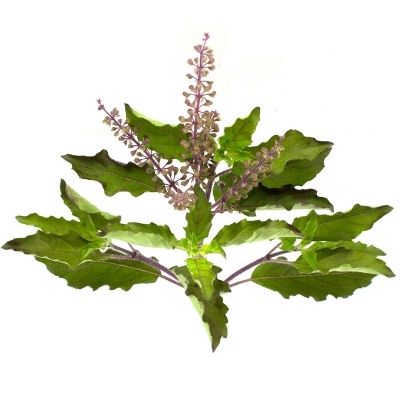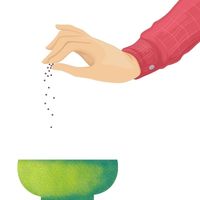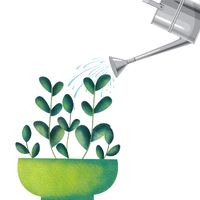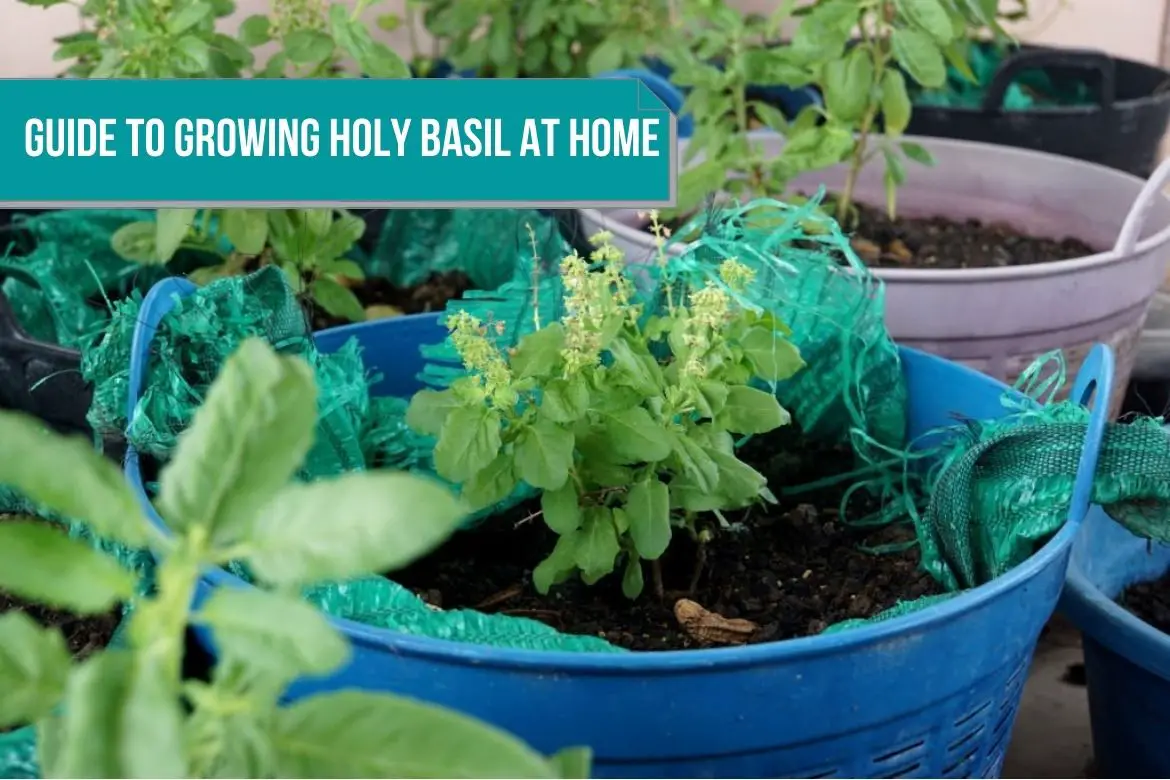
Botanical name : Ocimum gratissimum or Ocimum tenuiflorum
Flavor Profile : Peppery and spicy flavor with the undertones of Licorice, peppermint and clove.
As a plant native to India and a spicy version of sweet basil, holy basil is called ‘bai gaprow‘ in Thai and ‘tulasi / tulsi‘ in Sanskrit. It is also called ‘The Queen of Herbs’ or ‘Queen of Ayurveda’.
Throughout India, Hindus consider this plant sacred. Many homes have Tulasi/Tulsi holy basil plants on their property, and many devotees use this herb plant in their daily worship rituals.
Curry dishes with hearty, meaty flavors call for holy basil’s pungent, hot taste. Typically, raw leaves of holy basil are not consumed. It is more flavourful when cooked. However, make sure to use the leaves in tiny quantities as holy basil has an intense peppery flavor ( This is the reason why its also called as ‘hot basil’).
Holy basil does not even belong to the sweet basil species you’re used to finding in Italian cuisine. It belongs to the mint family.
Varieties of holy basil
- Rama Tulsi – It has a mellower flavor
- Krishna Tulsi – More pungent, stronger, and spicy flavor
- Vana Tulsi – Considered as the best tasting out of the three.
- Kapoor Tulsi – Most commonly grown shorter variety. Mild taste
- Amrita Tulsi – Less commonly grown perennial plant. Preferred for container growing
Health benefits of Holy Basil
Ayurveda (the traditional medicine of India) uses holy basil to make medicinal teas, oils, and poultices. Since millennia, it has been regarded as both a stress reliever and an immune booster. Often consumed as tea, Holy basil is high in potassium, calcium, vitamin A, and vitamin C. Among other medicinal uses, holy basil has been used as a treatment for colds, bronchitis, asthma, fevers, stomach upsets, arthritis, and headaches due to its antioxidant, antibacterial, and anti-inflammatory properties. Tulasi water also helps keep acidity in check.
How to grow Holy Basil indoors
A tropical perennial, holy basil grows well in containers or pots indoors. Put it in a window that gets plenty of sunlight.
It is a beautiful and rewarding herb to have in your garden or houseplant collection whether you grow it for medicinal, culinary, spiritual or aesthetic purposes.
Plant size

12 – 18 inches ( 30 – 45 cm ). Also, depends on the variety.
Container / pot Size

9 inches Diameter ( 22 cm ) or 2 gallons ( 7.5 liters )
Refer how to choose the right container for your indoor plants for more details.
Sunlight

Full Sun. A lot of light is essential for growing holy basil (a south-facing sunny windowsill can be a good place to place the container). 4 – 6 hours of direct sunlight is good.
Place in a warm room. A small fan blowing away from the container can be used to provide ventilation if needed.
Remember, its native to tropical region. Hence trying to place the container in temperature around 70 degree Fahrenheit (21 degree Celsius) is advisable. Try to keep the plant in temperatures above 50 F (10 C). However, as a thumb rule, keep it away from extreme temperatures.
Refer Best locations and Light requirements for indoor plants for more details.
Soil

Sandy loam, moist, rich in organic matter and well drained potting mix. Holy basil plant also prefers slightly acidic soil, however, the plant is mostly adaptable to any soil pH. Soil temperature of 60-70 degrees F (15-21 C) is advisable.
You can mix compost in the potting mix in the ration of 50:50.
Sowing

Can be sown by seeds or young plants from nursery. Sow the seeds any time. However, sowing the seeds in late spring and early summer is advisable. Plant seeds 1/4th of an inch deep in the potting mix.
Keep a distance of almost 8 inches between the two seeds. (you can also change this spacing based on your experience. Usually a spacing of 12 inches is recommended). It is important to ventilate holy basil properly since it is susceptible to fungi. Avoid bunching of the the plants. In almost 40 days the plant will reach maturity.
To graft or transplant, make an angled cut 6 inches below the leaf node with sanitized snips or a sharp grafting knife. The lower leaves of the cutting must be removed. Place the cutting in a jar with water. Changing the water frequently is necessary. Let the roots develop before transplanting the cutting into good quality potting soil.
Quick tip: Holy Basil will start germinating in 7-14 days. You can start transplanting the holy basil plant to individual containers as soon as 3-4 set of leaves (cotyledons) appear on the plant.
Watering

There are quite a few things to keep in mind when watering holy basil. Holy basil thrives in damp, free-draining conditions. In wet or waterlogged soil, holy basil quickly becomes infected with fungal diseases.
Holy basil needs plenty of drainage holes in the pot it is planted in, and it should be watered every two to three days. To make it simple, water the plant whenever the soil feels dry to the touch.
Refer How to make drainage holes on potting container for more details.
You can also protect your holy basil from diseases by not wetting the leaves. Additionally, wet leaves will become yellow in the sun.
Quick tip: You should water the plant only around its base and not over its leaves. To prevent soil over-saturation, you can also spray water on the soil with a spray bottle.
Harvesting

Throughout the season, clip or gently pinch off the leaves as they mature. You can start with those at the very top and new ones will grow.
You should avoid removing the lower, woody sections of the stems. Make sure you harvest everything before the first fall frost.
Plant care

As soon as you see flowers, cut them to encourage new growth and avoid seeding. Take special care of the plant in frost conditions.
For a leafy crop, you can also apply an all-purpose liquid fertilizer (10-10-10) to mature holy basil plants every 2 weeks. However, if the potting mix is of good quality, this is an optional practice.
SUBSTITUTES FOR HOLY BASIL IN THE KITCHEN
- Basil with mint
- Basil with red pepper flakes
- Basil with black pepper
- Thai Basil with mint
- Thai Basil with black pepper
How to keep Holy basil fresh
Dried holy basil is consumed as a herbal tea. However, some of the punch from the herb will be lost. Store the dried holy basil in air tight container. If you wish to soften the dried holy basil, soak them in cold water for 10-15 minutes.

One trick you can use is if you think that your dried holy basil is lacking some taste, you can add some Thai basil to elevate the flavor as per your need.
You can also freeze holy basil in ice-cube trays.
Please refer to how to store herbs and spices for more details.
How to use Holy basil in the kitchen
The addition of holy basil to Thai stir-fries is a signature taste of the cuisine, along with garlic, fish sauce, and fresh chili peppers. Besides meaty curries, it is also used to flavor fish, tofu, and various Asian veggie dishes, adding a unique fiery hot undertone.
Dishes : Noodles, curries, rice, stir-fries, tea.
Preparation : Used as whole leaves or can be torn into smaller pieces depending on the size and cuisine. Also used in dry state.
Pairing Holy basil with food
Seasoning : Chili peppers, lime juice, mints, Garlic, makrut lime, cilantro, curry powder and paste, turmeric, fish sauce, lemongrass, tamarind, red pepper flakes, vanilla, galangal, lemon juice, soy sauce, ginger, cumin.
Fruits and Vegetables : Mushrooms (Enoki Mushroom, Morel Mushroom, White Mushroom / Button mushroom, Cremini Mushroom, Portabella Mushroom, Shiitake Mushroom, Maitake Mushroom, Chanterelle Mushrooms, Oyster Mushroom), celery, baby corn, zucchini, Potatoes ( White Potato, Red Potato, Russet Potato, Purple Potato ), Eggplant, Green Beans, radishes, cabbage ( red cabbage, green cabbage ), mango, pineapple, carrots, bamboo shoots, tomatoes, snap peas, bean sprouts, scallions, coconut milk, onions.
Proteins : Fish and seafood, Eggs, Chicken, Pork, Beef, peanut, duck, tofu, cachews.

